Anas Chaaban
School of Engineering, University of British Columbia, Kelowna, Canada
Delay-Augmented Stacked Intelligent Surfaces: Potential, Challenges, and Opportunities
Oct 01, 2025Abstract:Stacked intelligent surfaces (SIS)s have been proposed recently as an enabling technology for Holographic Multiple Input Multiple Output (HMIMO) and Ultra-massive MIMO (umMIMO) technologies. Their utility can extend beyond spatial wave-domain processing of signals if they are enhanced with strategically-tuned symbol-duration level delays to enable temporal processing as well. In this work, we introduce the idea of a delay-augmented SIS (DA-SIS). We shed light on the feasibility of realizing delay units in an SIS. Then, we discuss the relevance of the proposed DA-SIS and present a use case that illustrates its potential, wherein the DA-SIS serves as an analog equalizer that aids in eliminating multi-path-induced inter-symbol-interference (ISI). We show how the number of elements affect the equalization process using the bit error rate (BER) as a metric, and demonstrate the potential of the DA-SIS in equalization via comparing with digital equalizers as a benchmark. Finally, we present opportunities and future research directions that can be undertaken to bring this idea to fruition.
Tri-Hybrid Multi-User Precoding Using Pattern-Reconfigurable Antennas: Fundamental Models and Practical Algorithms
May 13, 2025Abstract:The integration of pattern-reconfigurable antennas into hybrid multiple-input multiple-output (MIMO) architectures presents a promising path toward high-efficiency and low-cost transceiver solutions. Pattern-reconfigurable antennas can dynamically steer per-antenna radiation patterns, enabling more efficient power utilization and interference suppression. In this work, we study a tri-hybrid MIMO architecture for multi-user communication that integrates digital, analog, and antenna-domain precoding using pattern-reconfigurable antennas. For characterizing the reconfigurability of antenna radiation patterns, we develop two models -- Model~I and Model~II. Model~I captures realistic hardware constraints through limited pattern selection, while Model~II explores the performance upper bound by assuming arbitrary pattern generation. Based on these models, we develop two corresponding tri-hybrid precoding algorithms grounded in the weighted minimum mean square error (WMMSE) framework, which alternately optimize the digital, analog, and antenna precoders under practical per-antenna power constraints. Realistic simulations conducted in ray-tracing generated environments are utilized to evaluate the proposed system and algorithms. The results demonstrate the significant potential of the considered tri-hybrid architecture in enhancing communication performance and hardware efficiency. However, they also reveal that the existing hardware is not yet capable of fully realizing these performance gains, underscoring the need for joint progress in antenna design and communication theory development.
Tri-Hybrid Multi-User Precoding Based on Electromagnetically Reconfigurable Antennas
May 04, 2025Abstract:The tri-hybrid precoding architecture based on electromagnetically reconfigurable antennas (ERAs) is a promising solution for overcoming key limitations in multiple-input multiple-output communication systems. Aiming to further understand its potential, this paper investigates the tri-hybrid multi-user precoding problem using pattern reconfigurable ERAs. To reduce model complexity and improve practicality, we characterize each antenna's radiation pattern using a spherical harmonics decomposition. While mathematically tractable, this approach may lead to over-optimized patterns that are physically unrealizable. To address this, we introduce a projection step that maps the optimized patterns onto a realizable set. Simulation results demonstrate that spherical harmonics-based radiation pattern optimization significantly enhances sum rate performance. However, after projection onto a realizable set obtained from real ERA hardware, the performance gain is notably reduced or even negligible, underscoring the need for more effective projection techniques and improved reconfigurable antenna hardware.
Enhanced Beampattern Synthesis Using Electromagnetically Reconfigurable Antennas
Mar 05, 2025Abstract:Beampattern synthesis seeks to optimize array weights to shape radiation patterns, playing a critical role in various wireless applications. In addition to theoretical advancements, recent hardware innovations have facilitated new avenues to enhance beampattern synthesis performance. This paper studies the beampattern synthesis problem using newly proposed electromagnetically reconfigurable antennas (ERAs). By utilizing spherical harmonics decomposition, we simultaneously optimize each antenna's radiation pattern and phase shift to match a desired beampattern of the entire array. The problem is formulated for both far-field and near-field scenarios, with the optimization solved using Riemannian manifold techniques. The simulation results validate the effectiveness of the proposed solution and illustrate that ERAs exhibit superior beampattern synthesis capabilities compared to conventional fixed radiation pattern antennas. This advantage becomes increasingly significant as the array size grows.
Federated Testing (FedTest): A New Scheme to Enhance Convergence and Mitigate Adversarial Attacks in Federating Learning
Jan 19, 2025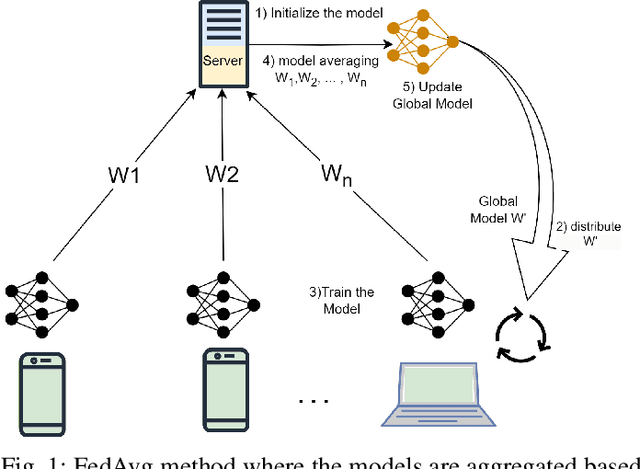
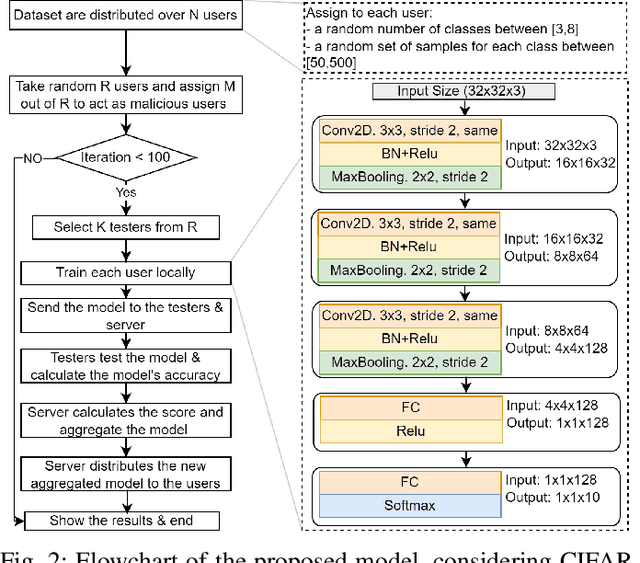
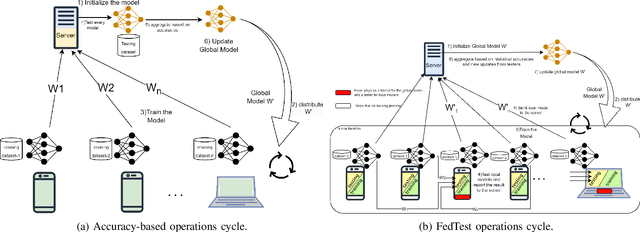
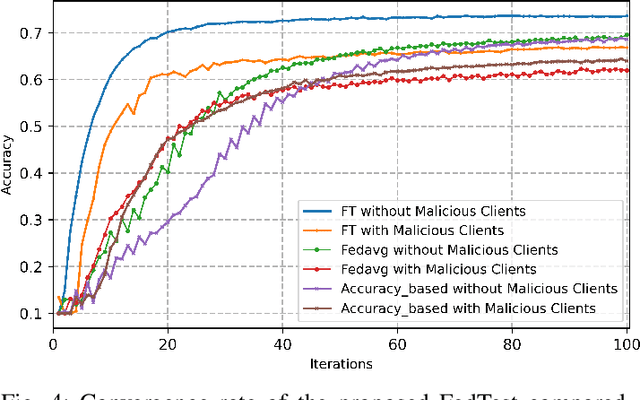
Abstract:Federated Learning (FL) has emerged as a significant paradigm for training machine learning models. This is due to its data-privacy-preserving property and its efficient exploitation of distributed computational resources. This is achieved by conducting the training process in parallel at distributed users. However, traditional FL strategies grapple with difficulties in evaluating the quality of received models, handling unbalanced models, and reducing the impact of detrimental models. To resolve these problems, we introduce a novel federated learning framework, which we call federated testing for federated learning (FedTest). In the FedTest method, the local data of a specific user is used to train the model of that user and test the models of the other users. This approach enables users to test each other's models and determine an accurate score for each. This score can then be used to aggregate the models efficiently and identify any malicious ones. Our numerical results reveal that the proposed method not only accelerates convergence rates but also diminishes the potential influence of malicious users. This significantly enhances the overall efficiency and robustness of FL systems.
Covertness in the Near Field: Maximizing the Covert Region with FDA
Nov 22, 2024Abstract:Covert communication in wireless networks ensures that transmissions remain undetectable to adversaries, making it a potential enabler for privacy and security in sensitive applications. However, to meet the high performance and connectivity demands of sixth-generation (6G) networks, future wireless systems will require larger antenna arrays, higher operating frequencies, and advanced antenna architectures. This shift changes the propagation model from far-field planar-wave to near-field spherical-wave which necessitates a redesign of existing covert communication systems. Unlike far-field beamforming, which relies only on direction, near-field beamforming depends on both distance and direction, providing additional degrees of freedom for system design. In this paper, we aim to utilize those freedoms by proposing near-field Frequency Diverse Array (FDA)-based transmission strategies that manipulate the beampattern in both distance and angle, thereby establishing a non-covert region around the legitimate user. Our approach takes advantage of near-field properties and FDA technology to significantly reduce the area vulnerable to detection by adversaries while maintaining covert communication with the legitimate receiver. Numerical simulations show that our methods outperform conventional phased arrays by shrinking the non-covert region and allowing the covert region to expand as the number of antennas increases.
From Centralized RAN to Open RAN: A Survey on the Evolution of Distributed Antenna Systems
Nov 19, 2024Abstract:Next-generation mobile networks require evolved radio access network (RAN) architectures to meet the demands of high capacity, massive connectivity, reduced costs, and energy efficiency, and to realize communication with ultra-low latency and ultra-high reliability. {Meeting such} requirements for both mobile users and vertical industries in the next decade {requires novel solutions. One of the potential solutions that attracted significant research attention in the past 15 years} is to redesign the radio access network (RAN). In this survey, we present a comprehensive survey on distributed antenna system (DAS) architectures that address these challenges and improve network performance. We cover the transition from traditional decentralized RAN to DAS, including cloud radio-access networks (C-RAN), fog radio-access networks (F-RAN), virtualized radio-access networks (V-RAN), cell-free massive multiple-input multiple-output (CF-mMIMO), and {the most recent advances manifested in} open radio-access network (O-RAN). In the process, we discuss the benefits and limitations of these architectures, including the impact of limited-capacity fronthaul links, various cooperative uplink and downlink coding strategies, cross-layer optimization, and techniques to optimize the performance of DAS. Moreover, we review key enabling technologies for next-generation RAN systems, such as multi-access edge computing, network function virtualization, software-defined networking, and network slicing; in addition to some crucial radio access technologies, such as millimeter wave, massive multi-input multi-output, device-to-device communication, and massive machine-type communication. Last but not least, we discuss the major research challenges in DAS and identify several possible directions for future research.
A Tunable Reflection Surface with Independently Variable Phase and Slope
Mar 04, 2024Abstract:A reconfigurable intelligent surface (RIS) is an essential component in the architecture of the next generation of wireless communication systems. An RIS is deployed to provide a controllability to the multi-path environment between the transmitter and the receiver, which becomes critical when the line-of-sight signal between them is blocked. In this work, we design an electrically tunable linearly polarized RIS at 2.5 GHz that yields a controllable reflection phase and phase-frequency slope; in other words, we add tunability of the phase-frequency slope to the tunability of the resonance center frequency. The proposed design consists of two layers of unit cells placed over a ground plane, with dog-bone-shaped elements in the top layer and patch elements in the bottom layer. Each patch and dog-bone element is loaded with a varactor, whose reverse bias voltage is controlled to provide a phase-frequency profile with a slope value of 9 degrees/MHz or 0.95 degrees/MHz, and a phase shift range of 320 degrees.
Transformer Masked Autoencoders for Next-Generation Wireless Communications: Architecture and Opportunities
Jan 11, 2024Abstract:Next-generation communication networks are expected to exploit recent advances in data science and cutting-edge communications technologies to improve the utilization of the available communications resources. In this article, we introduce an emerging deep learning (DL) architecture, the transformer-masked autoencoder (TMAE), and discuss its potential in next-generation wireless networks. We discuss the limitations of current DL techniques in meeting the requirements of 5G and beyond 5G networks, and how the TMAE differs from the classical DL techniques can potentially address several wireless communication problems. We highlight various areas in next-generation mobile networks which can be addressed using a TMAE, including source and channel coding, estimation, and security. Furthermore, we demonstrate a case study showing how a TMAE can improve data compression performance and complexity compared to existing schemes. Finally, we discuss key challenges and open future research directions for deploying the TMAE in intelligent next-generation mobile networks.
Hybrid Digital-Wave Domain Channel Estimator for Stacked Intelligent Metasurface Enabled Multi-User MISO Systems
Sep 28, 2023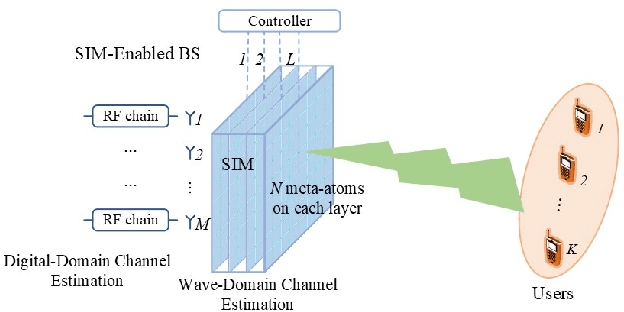
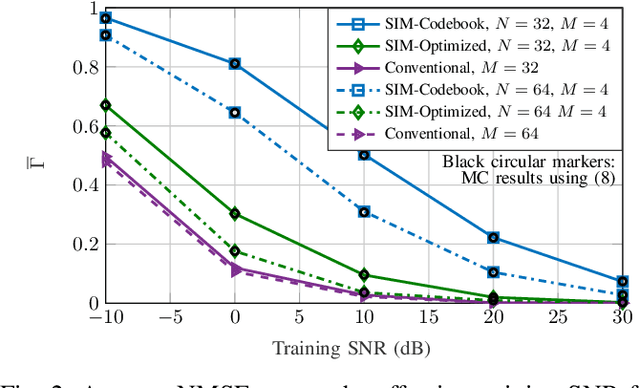
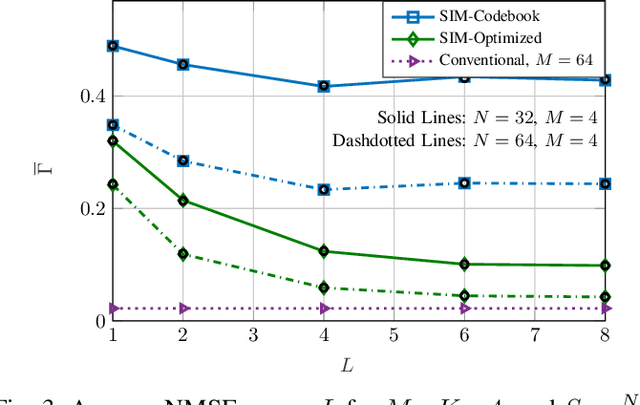
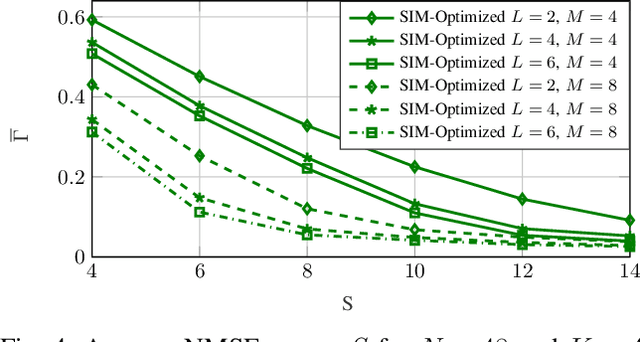
Abstract:Stacked intelligent metasurface (SIM) is an emerging programmable metasurface architecture that can implement signal processing directly in the electromagnetic wave domain, thereby enabling efficient implementation of ultra-massive multiple-input multiple-output (MIMO) transceivers with a limited number of radio frequency (RF) chains. Channel estimation (CE) is challenging for SIM-enabled communication systems due to the multi-layer architecture of SIM, and because we need to estimate large dimensional channels between the SIM and users with a limited number of RF chains. To efficiently solve this problem, we develop a novel hybrid digital-wave domain channel estimator, in which the received training symbols are first processed in the wave domain within the SIM layers, and then processed in the digital domain. The wave domain channel estimator, parametrized by the phase shifts applied by the meta-atoms in all layers, is optimized to minimize the mean squared error (MSE) using a gradient descent algorithm, within which the digital part is optimally updated. For an SIM-enabled multi-user system equipped with 4 RF chains and a 6-layer SIM with 64 meta-atoms each, the proposed estimator yields an MSE that is very close to that achieved by fully digital CE in a massive MIMO system employing 64 RF chains. This high CE accuracy is achieved at the cost of a training overhead that can be reduced by exploiting the potential low rank of channel correlation matrices.
 Add to Chrome
Add to Chrome Add to Firefox
Add to Firefox Add to Edge
Add to Edge